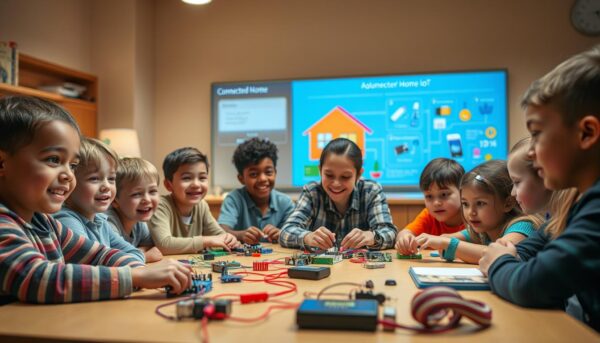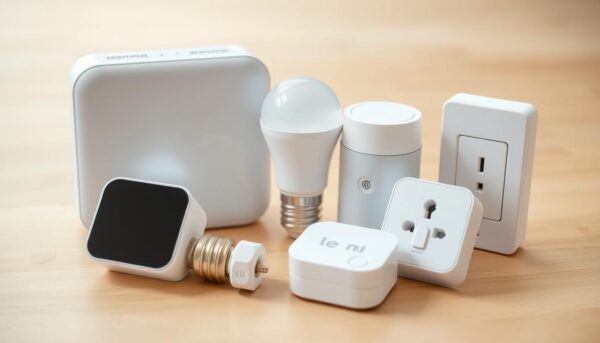✅ Last checked on
Imagine turning everyday household tasks into interactive experiments. Companies like Level Home and Teknikio prove automation isn’t just for adults. Young minds can design voice-controlled gadgets, program mood lighting, or create security alerts using simple tools.
These activities blend creativity with real-world tech skills. Kids learn coding basics while building devices that respond to claps, motion, or schedules. It’s like combining Legos with circuit boards – hands-on play that sparks problem-solving.
You don’t need expensive kits. Repurposing old speakers or light switches teaches sustainability alongside engineering. Brands emphasize safety-first designs, letting children explore without risks. The result? Confidence grows as they see their inventions control real parts of the house.
Key Takeaways
- Transform basic home devices into educational tools using guided experiments
- Combine coding fundamentals with practical engineering concepts
- Use everyday materials to teach resourcefulness and eco-conscious habits
- Prioritize safety with age-appropriate components from trusted brands
- Boost problem-solving skills through tangible, reward-driven challenges
Introduction to Smart Home Projects for Kids
Curious young minds thrive when given tools to shape their environment. Home automation, at its core, means teaching devices to work together through programmed rules. Think of it as training a team of helpers – lights that switch on at sunset or fans that cool rooms when sensors detect warmth.

Simplifying Tech Concepts
Explaining automation starts with relatable comparisons. “It’s like teaching your toys to dance when you clap,” you might say. Voice commands become magic words, while scheduling tools act as invisible assistants. Platforms like home automation basics break down complex ideas into building-block lessons.
“When children program a lamp to blink Morse code, they’re not just coding – they’re bridging abstract ideas with physical results.”
Why Early Exposure Matters
Practical tech activities build three key skills:
| Aspect | Traditional Learning | Automation Projects |
|---|---|---|
| Problem-Solving | Worksheet exercises | Real-time device troubleshooting |
| Engagement | Passive observation | Tangible cause-effect creation |
| Skill Development | Theoretical knowledge | Coding + engineering integration |
Seven-year-old Mia’s story shows the impact. She programmed holiday lights to flash when her hamster approached the cage door – combining safety awareness with creative coding. These experiences turn “I can’t” into “I designed this myself,” fostering lasting confidence.
Getting Started with Home Automation Basics
Building your first automated setup starts with choosing the right tools. Focus on devices that respond to simple commands and adapt to daily routines. A well-planned system turns ordinary spaces into interactive learning labs without overwhelming beginners.

Essential Devices, Sensors, and Set-Up Tips
Start with these components for easy experimentation:
| Device Type | Common Uses | Beginner Tips |
|---|---|---|
| Motion Sensors | Trigger lights or alarms | Place 4-5 ft high in corners |
| Smart Plugs | Schedule appliances | Label cords for easy identification |
| Light Kits | Create color patterns | Use app presets first |
Follow these steps to set up devices in any room:
- Download your chosen control app (like Kasa or Wyze)
- Position sensors where they’ll detect movement naturally
- Test connections using the system’s pairing mode
Avoid common mistakes like placing devices near metal surfaces or skipping software updates. Time-based automations work best when synced with actual routines – try programming lights to dim at bedtime first. Simple ideas often yield the clearest lessons in how systems interpret commands.
smart home projects for kids: DIY Ideas and Inspiration
Turning bedrooms into innovation labs starts with accessible tech experiments. Beginner-friendly kits transform ordinary objects into interactive systems, letting young creators design solutions for everyday scenarios.
Engaging Projects That Spark Creativity
Challenge young minds with these hands-on activities:
- Voice-activated nightlights using modular circuits
- Motion-sensor pet feeders with cardboard prototypes
- Weather stations that trigger room color changes
Teknikio’s classroom kits demonstrate how students built remote-controlled blinds that open when sunlight hits sensors. These experiments turn abstract concepts into tactile experiences.
Using DIY Starter Kits to Build Confidence in Tech
Kits like Tekniverse simplify electronics through color-coded connectors and illustrated guides. Kids assemble working systems within minutes, then modify variables like timing or sensitivity. One parent shared: “Watching my daughter program a doorbell that plays her favorite song erased her fear of coding.”
“Starter kits act as training wheels – they provide structure while leaving room for personal flair.”
Integrating Learning with Practical Automation
Every project becomes a stealth lesson. Building a security system with light triggers teaches:
- Circuit logic through trial and error
- Troubleshooting sensor placement
- Creative problem-solving when parts behave unexpectedly
Explore DIY tech project ideas that balance education with excitement. The best creations often emerge from “What if we tried…” moments.
Integrating Smart Lights, Thermostats, and Security Devices
Light up learning opportunities by merging voice commands with programmable devices. Combine color-changing bulbs, temperature sensors, and motion detectors to build responsive environments. This approach teaches how systems communicate while solving real challenges like energy efficiency or room customization.
Smart Lighting Ideas and Voice Control Features
Start with bulbs that adapt to routines. Philips Hue or LIFX models let you program colors through apps like Alexa or Google Home. Try these setups:
- Set lamps to glow blue when outdoor temperatures drop below 50°F
- Create “study mode” lighting that activates via voice command
- Sync porch lights with sunset times using geofencing
Voice controls turn basic tasks into interactive games. Kids can practice clear enunciation by programming phrases like “Lights, adventure mode!” to trigger rainbow effects.
| Bulb Type | Best For | Connection Time |
|---|---|---|
| RGB LED | Color experiments | 3-5 minutes |
| Dimmable White | Task lighting | 2-4 minutes |
| Motion-Activated | Hallways/entryways | 5-7 minutes |
Automated Thermostat and Temperature Regulation Tips
Nest and Ecobee devices offer hands-on climate control lessons. Program them to:
- Lower heat when windows open (using contact sensors)
- Boost airflow during homework hours
- Display energy usage stats on smart displays
Create “temperature zones” by placing sensors in different rooms. Compare readings to discuss insulation basics. Always set maximum/minimum limits to prevent extreme adjustments.
Innovative Technology and Sensor-Driven Projects
Invisible helpers now shape modern living spaces through connected devices. Sensors act as digital eyes and ears, feeding data to apps that make real-time decisions. This fusion creates opportunities to design responsive systems that adapt to daily life.
Incorporating IoT and Remote Monitoring
Advanced setups use multiple sensors to monitor environments. A security camera might activate lights when motion is detected, while air quality trackers adjust ventilation. These devices share data through cloud platforms, letting you view stats from any location.
| Sensor Type | Common Uses | Setup Complexity |
|---|---|---|
| Motion Detection | Security alerts | Low |
| Temperature | Climate control | Medium |
| Humidity | Plant care systems | High |
Creative ideas merge basic automation with new tech features:
- Build a window alarm using magnetic contact sensors
- Design a pet cam that dispenses treats via app commands
- Program lights to flash when mail arrives
Cloud integration turns local devices into smart networks. View live video feeds or receive moisture alerts for houseplants through your phone. One family created a “weather station” that changes room colors based on outdoor conditions – combining environmental sensing with visual feedback.
“The best systems feel like magic but teach the science behind the curtain.”
Follow these steps to add video features:
- Choose cameras with night vision and two-way audio
- Position devices to cover key areas without privacy concerns
- Use apps like TinyCam to create custom monitoring dashboards
Practical Guidance and Step-by-Step Instructions
Mastering automation begins with methodical preparation and precise execution. Start by sketching your design on paper – note device placements, connection points, and desired triggers. This blueprint prevents confusion during assembly and helps identify potential conflicts early.
Planning, Assembling, and Testing Your Projects
Follow this sequence for reliable results:
- Map device locations in your room using grid paper
- Connect power sources before pairing components
- Test individual features before linking systems
When programming light bulbs, verify color accuracy through multiple app commands. A student in Texas discovered their RGB strips showed incorrect hues until they adjusted voltage settings – a fix documented in IoT project ideas tutorials.
Troubleshooting Common Issues and Optimizing Performance
Address these frequent challenges:
| Issue | Solution | Tool |
|---|---|---|
| Unresponsive devices | Check power cycles | Multimeter |
| Delayed commands | Reboot router | Network analyzer |
| Flickering lights | Update firmware | Manufacturer app |
Review system video logs to pinpoint when errors occur. If motion sensors fail at night, increase infrared sensitivity or reposition units. Most performance gains come from incremental adjustments rather than overhauls.
Conclusion
What begins as a playful experiment with blinking lights evolves into foundational tech literacy. Through guided automation activities, young creators discover how everyday systems function while shaping their environments. These hands-on experiences transform abstract concepts into tangible skills – programming lights to welcome them after school or designing temperature alerts for their rooms.
Start with simple setups: voice-controlled lamps or scheduled night lights. Gradually explore sensor-driven systems that respond to movement or weather changes. Each project reinforces critical thinking through trial, error, and creative problem-solving.
Successful integration relies on balancing safety with curiosity. Use age-appropriate devices from trusted brands, and prioritize clear app controls. Whether programming morning routines or cloud-based monitoring tools, every adjustment teaches real-world engineering principles.
Ready to begin? Revisit the step-by-step guides for lighting configurations and voice command setups. Customize projects to match interests – maybe a plant hydration tracker or a color-coded homework reminder system. Start small, iterate often, and watch confidence grow with each functioning creation.